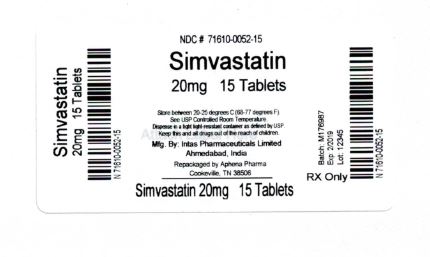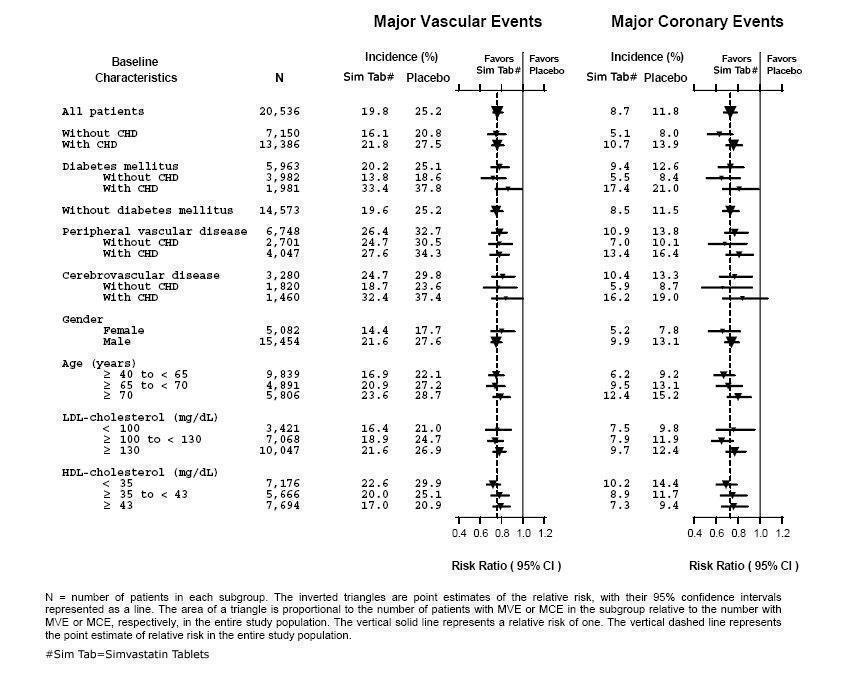Drug Catalog - Product Detail
SIMVASTATIN TB 20MG 1000
| NDC | Mfr | Size | Str | Form |
|---|---|---|---|---|
| 16729-0005-17 | ACCORD HEALTHCARE | 1000 | 20MG | TABLET |
PACKAGE FILES




Generic Name
Substance Name
Product Type
Route
Application Number
Description
11. DESCRIPTION Simvastatin is a lipid-lowering agent that is derived synthetically from a fermentation product of Aspergillus terreus . After oral ingestion, simvastatin, which is an inactive lactone, is hydrolyzed to the corresponding β-hydroxyacid form. This is an inhibitor of 3-hydroxy-3-methylglutaryl-coenzyme A (HMG-CoA) reductase. This enzyme catalyzes the conversion of HMG-CoA to mevalonate, which is an early and rate-limiting step in the biosynthesis of cholesterol. Simvastatin is butanoic acid, 2,2-dimethyl-,1,2,3,7,8,8a-hexahydro-3,7-dimethyl-8-[2-(tetrahydro-4-hydroxy-6-oxo-2 H -pyran-2-yl)-ethyl]-1-naphthalenyl ester, [1 S -[1α,3α,7β,8β(2 S* ,4 S* ),-8aβ]]. The empirical formula of simvastatin is C 25 H 38 O 5 and its molecular weight is 418.57. Its structural formula is: Simvastatin is a white to off-white, nonhygroscopic, crystalline powder that is practically insoluble in water, and freely soluble in chloroform, methanol and ethanol. Simvastatin tablets USP for oral administration contain either 5 mg, 10 mg, 20 mg, 40 mg or 80 mg of simvastatin and the following inactive ingredients: microcrystalline cellulose, hydroxypropyl cellulose, hypromellose E5, croscarmellose sodium, ferric oxide red, lactose monohydrate, magnesium stearate, maize starch, talc, titanium dioxide, butylated hydroxyanisole , ascorbic acid, citric acid monohydrate, and triethyl citrate. Simvastatin
How Supplied
16. HOW SUPPLIED/STORAGE AND HANDLING Simvastatin tablets USP 5 mg are brick red coloured, round shaped, biconvex, film coated tablet debossed “SI” on one side and plain on other side. Bottles of 30 Tablets (NDC 16729-156-10) Bottles of 90 Tablets (NDC 16729-156-15) Bottles of 1000 Tablets (NDC 16729-156-17) Simvastatin tablets USP 10 mg are brick red coloured, oval shaped, biconvex, film-coated tablets, debossed "S 4" on one side and plain on other side. Bottles of 30 Tablets (NDC 16729-004-10) Bottles of 60 Tablets (NDC 16729-004-12) Bottles of 90 Tablets (NDC 16729-004-15) Bottles of 1000 Tablets (NDC 16729-004-17) Simvastatin tablets USP 20 mg are brick red coloured oval shaped, biconvex, film-coated tablets, debossed "S 5" on one side and plain on other side. Bottles of 30 Tablets (NDC 16729-005-10) Bottles of 60 Tablets (NDC 16729-005-12) Bottles of 90 Tablets (NDC 16729-005-15) Bottles of 1000 Tablets (NDC 16729-005-17) Simvastatin tablets USP 40 mg are brick red coloured, oval shaped, biconvex, film-coated tablets, debossed "S 6" on one side and plain on other side. Bottles of 30 Tablets (NDC 16729-006-10) Bottles of 60 Tablets (NDC 16729-006-12) Bottles of 90 Tablets (NDC 16729-006-15) Bottles of 1000 Tablets (NDC 16729-006-17) Simvastatin tablets USP 80 mg are brick red coloured,capsule-shaped, biconvex, film-coated tablets, debossed with "SMV" on one side and "80" on the other side. Bottles of 30 Tablets (NDC 16729-007-10) Bottles of 60 Tablets (NDC 16729-007-12) Bottles of 90 Tablets (NDC 16729-007-15) Bottles of 1000 Tablets (NDC 16729-007-17) Storage Store at 20°C to 25°C (68°F to 77°F). [See USP Controlled Room Temperature]. "Dispense in tight containers as defined in the USP"
Indications & Usage
1. INDICATIONS AND USAGE Therapy with lipid-altering agents should be only one component of multiple risk factor intervention in individuals at significantly increased risk for atherosclerotic vascular disease due to hypercholesterolemia. Drug therapy is indicated as an adjunct to diet when the response to a diet restricted in saturated fat and cholesterol and other nonpharmacologic measures alone has been inadequate. In patients with coronary heart disease (CHD) or at high risk of CHD, simvastatin tablets can be started simultaneously with diet. Simvastatin tablets are an HMG-CoA reductase inhibitor (statin) indicated as an adjunctive therapy to diet to: Reduce the risk of total mortality by reducing CHD deaths and reduce the risk of non-fatal myocardial infarction, stroke, and the need for revascularization procedures in patients at high risk of coronary events. ( 1.1 ) Reduce elevated total-C, LDL-C, Apo B, TG and increase HDL-C in patients with primary hyperlipidemia (heterozygous familial and nonfamilial) and mixed dyslipidemia. ( 1.2 ) Reduce elevated TG in patients with hypertriglyceridemia and reduce TG and VLDL-C in patients with primary dysbeta-lipoproteinemia. ( 1.2 ) Reduce total-C and LDL-C in adult patients with homozygous familial hypercholesterolemia. ( 1.2 ) Reduce elevated total-C, LDL-C, and Apo B in boys and postmenarchal girls, 10 to 17 years of age with heterozygous familial hypercholesterolemia after failing an adequate trial of diet therapy. ( 1.2 , 1.3 ) Limitations of Use Simvastatin tablets have not been studied in Fredrickson Types I and V dyslipidemias. ( 1.4 ) 1.1 Reductions in Risk of CHD Mortality and Cardiovascular Events In patients at high risk of coronary events because of existing coronary heart disease, diabetes, peripheral vessel disease, history of stroke or other cerebrovascular disease, simvastatin tablets are indicated to: Reduce the risk of total mortality by reducing CHD deaths. Reduce the risk of non-fatal myocardial infarction and stroke. Reduce the need for coronary and non-coronary revascularization procedures. 1.2 Hyperlipidemia Simvastatin tablets are indicated to: Reduce elevated total cholesterol (total-C), low-density lipoprotein cholesterol (LDL-C), apolipoprotein B (Apo B), and triglycerides (TG), and to increase high-density lipoprotein cholesterol (HDL-C) in patients with primary hyperlipidemia (Fredrickson type IIa, heterozygous familial and nonfamilial) or mixed dyslipidemia (Fredrickson type IIb). Reduce elevated TG in patients with hypertriglyceridemia (Fredrickson type lV hyperlipidemia). Reduce elevated TG and VLDL-C in patients with primary dysbetalipoproteinemia (Fredrickson type III hyperlipidemia). Reduce total-C and LDL-C in patients with homozygous familial hypercholesterolemia (HoFH) as an adjunct to other lipid-lowering treatments (e.g., LDL apheresis) or if such treatments are unavailable. 1.3 Adolescent Patients with Heterozygous Familial Hypercholesterolemia (HeFH) Simvastatin tablets are indicated as an adjunct to diet to reduce total-C, LDL-C, and Apo B levels in adolescent boys and girls who are at least one year post-menarche, 10 to 17 years of age, with HeFH, if after an adequate trial of diet therapy the following findings are present: LDL cholesterol remains ≥190 mg/dL; or LDL cholesterol remains ≥160 mg/dL and There is a positive family history of premature cardiovascular disease (CVD) or Two or more other CVD risk factors are present in the adolescent patient. The minimum goal of treatment in pediatric and adolescent patients is to achieve a mean LDL-C <130 mg/dL. The optimal age at which to initiate lipid-lowering therapy to decrease the risk of symptomatic adulthood CAD has not been determined. 1.4 Limitations of Use Simvastatin tablets have not been studied in conditions where the major abnormality is elevation of chylomicrons (i.e., hyperlipidemia Fredrickson types I and V).
Dosage and Administration
2. DOSAGE AND ADMINISTRATION Dose range is 5 to 40 mg/day. ( 2.1 ) Recommended usual starting dose is 10 or 20 mg once a day in the evening. ( 2.1 ) Recommended starting dose for patients at high risk of CHD is 40 mg/day. ( 2.1 ) Due to the increased risk of myopathy, including rhabdomyolysis, use of the 80-mg dose of simvastatin tablets should be restricted to patients who have been taking simvastatin 80 mg chronically (e.g., for 12 months or more) without evidence of muscle toxicity. ( 2.2 ) Patients who are currently tolerating the 80-mg dose of simvastatin tablets who need to be initiated on an interacting drug that is contraindicated or is associated with a dose cap for simvastatin should be switched to an alternative statin with less potential for the drug-drug interaction. ( 2.2 ) Due to the increased risk of myopathy, including rhabdomyolysis, associated with the 80-mg dose of simvastatin tablets, patients unable to achieve their LDL-C goal utilizing the 40-mg dose of simvastatin tablets should not be titrated to the 80-mg dose, but should be placed on alternative LDL-C-lowering treatment(s) that provides greater LDL-C lowering. ( 2.2 ) Adolescents (10 to 17 years of age) with HeFH: starting dose is 10 mg/day; maximum recommended dose is 40 mg/day. ( 2.5 ) 2.1 Recommended Dosing The usual dosage range is 5 to 40 mg/day. In patients with CHD or at high risk of CHD, simvastatin tablets can be started simultaneously with diet. The recommended usual starting dose is 10 or 20 mg once a day in the evening. For patients at high risk for a CHD event due to existing CHD, diabetes, peripheral vessel disease, history of stroke or other cerebrovascular disease, the recommended starting dose is 40 mg/day. Lipid determinations should be performed after 4 weeks of therapy and periodically thereafter. 2.2 Restricted Dosing for 80 mg Due to the increased risk of myopathy, including rhabdomyolysis, particularly during the first year of treatment, use of the 80-mg dose of simvastatin tablets should be restricted to patients who have been taking simvastatin 80 mg chronically (e.g., for 12 months or more) without evidence of muscle toxicity. [see Warnings and Precautions (5.1) ] Patients who are currently tolerating the 80-mg dose of simvastatin tablets who need to be initiated on an interacting drug that is contraindicated or is associated with a dose cap for simvastatin should be switched to an alternative statin with less potential for the drug-drug interaction. Due to the increased risk of myopathy, including rhabdomyolysis, associated with the 80-mg dose of simvastatin tablets, patients unable to achieve their LDL-C goal utilizing the 40-mg dose of simvastatin tablets should not be titrated to the 80-mg dose, but should be placed on alternative LDL-C-lowering treatment(s) that provides greater LDL-C lowering. 2.3 Coadministration with Other Drugs Patients taking Verapamil, Diltiazem, or Dronedarone The dose of simvastatin tablets should not exceed 10 mg/day [see Warnings and Precautions (5.1) , Drug Interactions (7.3) , and Clinical Pharmacology (12.3) ]. . Patients taking Amiodarone, Amlodipine or Ranolazine The dose of simvastatin tablets should not exceed 20 mg/day [see Warnings and Precautions (5.1) , Drug Interactions (7.3) , and Clinical Pharmacology (12.3) ]. 2.4 Patients with Homozygous Familial Hypercholesterolemia The recommended dosage is 40 mg/day in the evening [see Dosage and Administration, Restricted Dosing for 80 mg (2.2) ] . Simvastatin tablets should be used as an adjunct to other lipid-lowering treatments (e.g., LDL apheresis) in these patients or if such treatments are unavailable. Simvastatin exposure is approximately doubled with concomitant use of lomitapide; therefore, the dose of simvastatin tablets should be reduced by 50% if initiating lomitapide. Simvastatin tablets dosage should not exceed 20 mg/day (or 40 mg/day for patients who have previously taken simvastatin tablets 80 mg/day chronically, e.g., for 12 months or more, without evidence of muscle toxicity) while taking lomitapide. 2.5 Adolescents (10 to 17 years of age) with Heterozygous Familial Hypercholesterolemia The recommended usual starting dose is 10 mg once a day in the evening. The recommended dosing range is 10 to 40 mg/day; the maximum recommended dose is 40 mg/day. Doses should be individualized according to the recommended goal of therapy [see NCEP Pediatric Panel Guidelines National Cholesterol Education Program (NCEP): Highlights of the Report of the Expert Panel on Blood Cholesterol Levels in Children and Adolescents. Pediatrics 89(3):495-501. 1992. and Clinical Studies (14.2) ]. Adjustments should be made at intervals of 4 weeks or more. 2.6 Patients with Renal Impairment Because simvastatin tablets do not undergo significant renal excretion, modification of dosage should not be necessary in patients with mild to moderate renal impairment. However, caution should be exercised when simvastatin tablets are administered to patients with severe renal impairment; such patients should be started at 5 mg/day and be closely monitored [see Warnings and Precautions (5.1) and Clinical Pharmacology (12.3) ]. 2.7 Chinese Patients Taking Lipid-Modifying Doses (greater than or equal to 1 g/day Niacin) of Niacin-Containing Products Because of an increased risk for myopathy, in Chinese patients taking simvastatin 40 mg coadministered with lipid-modifying doses (greater than or equal to 1 g/day niacin) of niacin-containing products, caution should be used when treating Chinese patients with simvastatin doses exceeding 20 mg/day coadministered with lipid-modifying doses of niacin-containing products. Because the risk for myopathy is dose-related, Chinese patients should not receive simvastatin 80 mg coadministered with lipid-modifying doses of niacin-containing products. The cause of the increased risk of myopathy is not known. It is also unknown if the risk for myopathy with coadministration of simvastatin with lipid-modifying doses of niacin-containing products observed in Chinese patients applies to other Asian patients. [see Warnings and Precautions (5.1) ]
